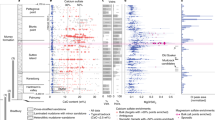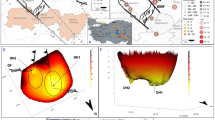Abstract
Evaporites hosted by red beds (red shales and sandstones), some 275–265 million years old, extend over a large area of the North American mid-continent1. They were deposited in non-marine saline lakes, pans and mud-flats2, settings that are typically assumed to have been alkaline. Here we use laser Raman microprobe analyses of fluid inclusions trapped in halites from these Permian deposits to argue for the existence of highly acidic (pH <1) lakes and ground waters. These extremely acidic systems may have extended over an area of 200,000 km2. Modern analogues of such systems may be natural acid lake and groundwater systems (pH ∼2–4) in southern Australia3,4,5,6,7,8,9. Both the ancient and modern acid systems are characterized by closed drainage, arid climate, low acid-neutralizing capacity, and the oxidation of minerals such as pyrite to generate acidity. The discovery of widespread ancient acid lake and groundwater systems demands a re-evaluation of reconstructions of surface conditions of the past, and further investigations of the geochemistry and ecology of acid systems in general.
This is a preview of subscription content, access via your institution
Access options
Subscribe to this journal
Receive 51 print issues and online access
$199.00 per year
only $3.90 per issue
Buy this article
- Purchase on Springer Link
- Instant access to full article PDF
Prices may be subject to local taxes which are calculated during checkout


Similar content being viewed by others
References
Walker, T. R. Formation of red beds in modern and ancient deserts. Geol. Soc. Am. Bull. 78, 353–368 (1967).
Benison, K. C. Acid Water Deposition and Diagenesis of Permian Red Bed-hosted Evaporites, Midcontinent, U.S.A.Thesis, Univ. Kansas((1997).
Alpers, C. N., Rye, R. O., Nordstrom, D. K., White, L. D. & King, B. S. Chemical, crystallographic and stable isotope properties of alunite and jarosite from acid-hypersaline Australian lakes. Chem. Geol. 96, 203–206 (1992).
Hines, M. E., Lyons, W. B., Lent, R. M. & Long, D. T. Sedimentary biogeochemistry of an acidic, saline groundwater discharge zone in Lake Tyrell, Victoria, Australia. Chem. Geol. 96, 53–65 (1992).
Long, D. T. & Lyons, W. B. Aridity, continental weathering, and groundwater chemistry. Geol. Soc. Am. Abstr. Progm. 22, 295 (1990).
Long, D. T. & Lyons, W. B. Aridity, continental weathering, and ground-water chemistry. Geol. Soc. Am. Today 2, 185–190 (1992).
Long, D. T. et al. Geochemistry of acid brines: Lake Tyrell, Victoria, Australia. Chem. Geol. 96, 33–52 (1992).
Macumber, P. G. Hydrological processes in the Tyrell Basin, southeastern Australia. Chem. Geol. 96, 1–18 (1992).
McArthur, J. M., Turner, J., Lyons, W. B., Osborn, A. O. & Thirwall, M. F. Hydrochemistry on the Yilgarn Block, Western Australia: Ferrolysis and mineralisation in acidic brines. Geochim. Cosmochim. Acta 55, 1273–1288 (1991).
Lowenstein, T. K. & Hardie, L. A. Criteria for the recognition of salt-pan evaporites. Sedimentology 32, 627–644 (1985).
Cunningham, K. M., Goldberg, M. C. & Weiner, E. R. Investigation of detection limits for solutes in water measured by laser Raman spectrometry. Anal. Chem. 49, 70–75 (1977).
Moissette, A., Dubessy, J., Cathlineau, M., Ramanaidou, E. & Le Gleuher, M. Fluids with high acidity evidenced by Raman analysis of sulfate and bisulfate ions in fluid inclusions from a gold showing (Brazil). IAGOD Symp. Progm. Abstr. A18 (1990).
Rosasco, G. J. & Roedder, E. Application of a new Raman microprobe spectrometer to nondestructive analysis of sulfate and other ions in individual phases in fluid inclusions in minerals. Geochim. Cosmochim. Acta 43, 1907–1915 (1979).
Dubessy, J., Boiron, M., Moissette, A., Monnin, C. & Stretenskaya, N. Determinations of water, hydrates, and pH of fluid inclusions by micro-Raman spectrometry. Eur. J. Min. 4, 885–894 (1992).
Plummer, L. N., Parkhurst, D. L., Fleming, G. W. & Dunkle, S. A. A Computer Program Incorporating Pitzer's Equations for Calculation of Geochemical Reactions in Brines (Water Res. Invest. Rep. 88-4153, US Geol. Surv., Reston, VA, 1988).
Turner, D. J. Raman spectral study of bisulphate ion hydration. J. Chem. Soc. Faraday Trans. 68, 643–648 (1972).
Rudolph, W. Structure and dissociation of the hydrogen sulphate ion in aqueous solution over a broad temperature range: a Raman study. Z. Phys. Chem. 194, 73–95 (1996).
Benison, K. C. Surface water paleotemperatures from Permian Nippewalla Group halite, Kansas. Carbonates Evaporites 10, 242–248 (1995).
Benison, K. C. & Goldstein, R. H. Permian paleoclimate data from fluid inclusions in halite. Chem. Geol.(in the press).
Hall, D. L., Bodnar, R. J. & Craig, J. R. Evidence for postentrapment diffusion of hydrogen into peak metamorphic fluid inclusions from the massive sulfide deposits at Ducktown, Tennessee. Am. Mineral. 76, 1344–1355 (1991).
Marvogenes, J. A. & Bodnar, R. J. Hydrogen movement into and out of fluid inclusions in quartz: Experimental evidence and geologic implications. Geochim. Cosmochim. Acta 58, 141–148 (1994).
Goldstein, R. H. & Reynolds, T. J. Systematics of Fluid Inclusions in Diagenetic Minerals 199 (Short Course 31, SEPM (Soc. for Sed. Geol.), Tulsa, OK, 1994).
Delmelle, P. & Bernard, A. Geochemistry, mineralogy, and chemical modeling of the acid crater lake of Kawak Ijen Volcano, Indonesia. Geochim. Cosmochim. Acta 58, 2445–2460 (1994).
Rowe, G. L. The Acid Crater Lake System of Poas Volcano, Costa Rica: Geochemistry, Hydrology, and Physical Characteristics.Thesis, Pennsylvania State Univ.((1991).
Nordstrom, D. K., Valentine, S. D., Ball, J. D., Plummer, L. N. & Jones, B. F. Measurement of negative pH values and high metal concentrations in extremely acidic mine waters from Iron Mountain, California. Geol. Soc. Am. Abstr. Progm. 23, 383 (1991).
Nordstrom, D. K. in Acid Sulfate Weathering (eds Kittrick, J. A., Fanning, D. S. & Hossner, L. R.) 37–56 (Spec. Publ. 10, Soil Sci. Soc. Am., Madison, WI, 1982).
Berendsen, P. Permian red bed copper mineralization in south-central Kansas. Acad. Sci. Trans. Abstr. 83, 122 (1980).
Hovorka, S. Depositional environments of marine-dominated bedded halite, Permian San Andres Formation, Texas. Sedimentology 34, 1029–1054 (1987).
Lowenstein, T. K. Origin of depositional cycles in a Permian “saline giant”: the Salado (McNutt zone) evaporites of New Mexico. Geol. Soc. Am. Bull. 100, 592–608 (1988).
Presley, M. W. Evolution of Permian evaporite basin in Texas panhandle. Bull. Am. Assoc. Petrol. Geol. Bull. 71, 167–190 (1987).
Acknowledgements
We thank T. K. Lowenstein and R. J. Bodnar for suggestions that improved this manuscript. This work was partially funded by NSF, GSA and Sigma Xi.
Author information
Authors and Affiliations
Corresponding author
Rights and permissions
About this article
Cite this article
Benison, K., Goldstein, R., Wopenka, B. et al. Extremely acid Permian lakes and ground waters in North America. Nature 392, 911–914 (1998). https://doi.org/10.1038/31917
Received:
Accepted:
Issue Date:
DOI: https://doi.org/10.1038/31917
This article is cited by
-
Isopiestic Determination of the Osmotic and Activity Coefficients of the {hH2SO4 + (1 − h)Al2(SO4)3}(aq) System at T = 298.15 K. 1. Experimental Results at Stoichiometric Ionic Molality Factions h = (0.85777, 0.71534, 0.57337, 0.42985, 0.28593, and 0.14332)
Journal of Solution Chemistry (2018)
-
Giant uranium deposits formed from exceptionally uranium-rich acidic brines
Nature Geoscience (2012)
Comments
By submitting a comment you agree to abide by our Terms and Community Guidelines. If you find something abusive or that does not comply with our terms or guidelines please flag it as inappropriate.



